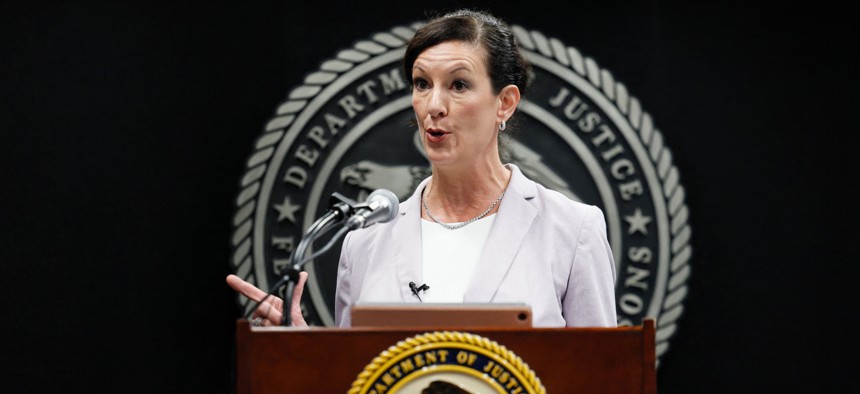
Bureau of Prisons Director Colette Peters said in a response to a IG report Thursday that he bureau has taken steps to mitigate the risk of inmate deaths. EVELYN HOCKSTEIN / Getty Images
Understaffing and mismanagement contributed to hundreds of deaths in federal prisons
Deaths have increased as agency staff fail to identify suicidal risks and allow contraband into facilities, IG finds.
Understaffing, insufficient training and poor management all contributed to hundreds of deaths at the Bureau of Prisons in a recent eight-year stretch, according to a new audit that found the agency was failing to address mental illness and ignoring policies designed to prevent suicide and homicides.
Nearly 350 inmates died in federal prisons between fiscal years 2014 and 2021, more than half of which were suicides. About 90 were homicides and 68 were accidental or of an unknown cause. Bureau deficiencies occurred in many of those deaths, including 40% of the suicides, the Justice Department’s inspector general found. Failures included in insufficient medical care, improper decisions regarding inmate housing, poor contraband screenings and a failure to communicate and coordinate efforts.
The federal prisons system has faced increased scrutiny in recent years following the high-profile deaths of James “Whitey” Bulger in 2018 and Jeffrey Epstein in 2019.
The deaths spiked in the most recent years the IG reviewed, driven primarily by an increase in suicides. The auditors found nearly half of suicides occurred in restrictive housing, despite only 8% of federal inmates living in such cells. Facility staff missed warning signs of inmates with elevated suicide risks, they said, and the watchdog called on the bureau to improve its mental health care designation process. The agency failed to conduct required suicide response training efforts, which left employees ill-equipped when those situations arose.
“These deficiencies helped foster conditions in which inmates were able to advance their suicidal ideations and created increased opportunities for them to die by suicide,” the IG said.
The watchdog noted that longstanding staffing issues contributed to the suicides and deaths overall, identifying it as a specific factor in 30 cases. Understaffing in Health Services and Psychological Services consistently led to insufficient care for mentally ill inmates, the IG found. At all of the IG’s site visits during its probe, bureau personnel identified understaffing as among the biggest contributors to deaths.
The auditors noted two longstanding practices at the agency—reassignment of non-correctional staff to correctional officer duties, or “augmentation,” and overtime—contributed to “staff fatigue, sleep deprivation, decreased vigilance and inattentiveness to duty.” At one facility, psychiatric staff were reassigned daily for two months straight. In another case, a facility did not have any psychological services personnel on staff.
The IG observed significant vacancies during its site visits. In one case, half of a facility’s nursing positions were unfilled. At another facility, employees worked double shifts for three consecutive days.
Personnel on staff are often undertrained, the IG found, with the bureau’s after action reviews identifying insufficient training as an issue in 42% of deaths. They are also improperly disciplined, with employees themselves telling the IG the process was too lengthy and ineffective.
Other bureau failures contributing to deaths included staff that was unsure how to de-escalate situations with inmates, forcing inmates with known suicidal risk factors to be housed in a cell alone; insufficient emergency response including not administering CPR, delaying the transfer of inmates to emergency care, a lack of urgency among staff and not using emergency equipment such as defibrillators; and conducting too few counts, rounds and cell searches. The latter issue stemmed from staffing shortfalls, the IG said.
The watchdog faulted the bureau for only requiring after action reports on suicides, but not other deaths. It called on the agency to centralize its post-death reviews so lessons could be learned on a broader basis.
In one-third of deaths, the IG found contraband drugs or weapons were involved. The bureau’s camera systems were often outdated, with either poor quality or not working at all.
“BOP should redouble its efforts to detect and interdict contraband in its institutions, including through efforts to screen staff, inmates and incoming mail; search housing units and personnel; supervise inmates who have opportunities to facilitate contraband introduction and transmission; and complete updates to its security camera system,” the IG said.
Bureau Director Colette Peters said in response to the report that any death in its custody is tragic and said the agency has taken several steps to mitigate risks. She added the inmate population has additional risk factors, which the bureau attempts to address proactively. In many cases, Peters said, inmates leave federal custody in better health than when they arrive.
“We have long prioritized suicide prevention,” the director said. “We train our employees on how to recognize risk indicators for suicide, get help for those at risk of suicide and respond when an individual is attempting suicide.”
Peters noted the bureau is improving inmates’ ability to communicate with family and friends and has ramped up its contraband eradication efforts. Ultimately, she called the IG’s report “thoughtful” and concurred with all 12 of its recommendations.







